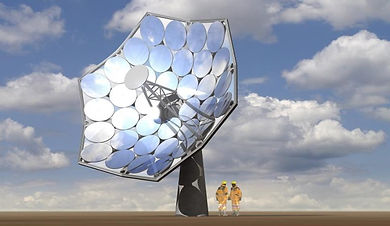Sunflowers

The way in which sunflower seeds and petals are laid out, as well as the swiveling head of sunflowers, maximizes the flower's exposure to the sun, and can be used as inspiration for ultra-efficient solar panels.
Biomimetic Designs
Solar Farm Layout:
In order to limit land use for solar farms, scientists re-arranged the positioning of solar panels to mimic the positioning of sunflowers' seeds and petals. Sunflowers have evolved to maximize their sun exposure, and therefore solar energy harvesting, by arranging petals and seeds in such a way that minimizes light blockage from petals or seeds. By copying this arrangement, solar farms are able to harvest more sunlight with the least amount of land use possible. Using this model, land use was reduced by 20% compared to regular solar farms.
Solar Electricity Generators:
IBM designed a 30-ft high solar electricity generator modeled after the sunflower's mathematical design. According to the company, the devices "can convert 80% of the sun’s radiation into electricity and hot water". Not only do the mirrors mimic sunflowers in their arrangement on the dish's surface, it also mimics sunflowers by tracking the sun throughout the day and positioning its face accordingly, known as heliotropism.


The Science Behind Sunflowers
The sequence in which many plants arrange their leaves and seeds, sunflowers included, is known as a Fibonacci spiral. This spiral occurs naturally by "coding" in the plant that sprouts consecutive leaves or petals in a way that limits the amount of sun coverage from one leaf to the next, resulting in an angle of about 137.5° between each sprout. Due to repetition, such angles form a Fibonacci spiral. Evidently, this exact distribution is the most beneficial, given that 90% of plants that feature spirals are perfect Fibonacci spirals. Such species include pine cones, roses, succulents, and even pineapples. Biologically, the spirals are tools to maximize resource efficiency, and set into place a pattern present through all stages of growth. Once formed, the spirals tend to reinforce each other and suppress any other arrangement.
Mathematically, this occurrence is fascinating, because of the consistent set of numbers present in spirals. Once formed, the ratio of the number of spirals in one direction to the number of spirals in the other direction creates the 'Golden Ratio', approximately 1.618. The set of numbers that are able to achieve this ratio are known as Fibonacci numbers, which come from adding the two consecutive numbers in the series to get the next number. When plotted onto a graph, these numbers form a perfect Fibonacci spiral, which are present in snail shells, cochlea, and even the Milky Way Galaxy spiral.


